Under the leadership of Graham Potter, Brighton & Hove Albion made immense progress in the Premier League, playing an attractive brand of football along the way. With the Englishman exiting to take the reigns at Chelsea, the opportunity to fill Potter’s boots became available. The club acted swiftly in appointing Italian manager Roberto de Zerbi, who had impressed in Serie A during his time with Sassuolo. There were elements in his tactics in Italy that matched the vision that Potter had started at Brighton, so it was a sensible appointment, not to mention an exciting one.
At the time of writing, the Seagulls are flying high following an emphatic 4-1 on Potter’s new club, Chelsea. However, prior to this fixture, their form was less than desirable, going winless in de Zerbi’s opening five fixtures. There were still signs of promise, though, and Potter himself even said during a press conference that his old side have performed well under new leadership, but they were just unlucky – not to mention a number of difficult games against giants like Liverpool, Manchester City, and Tottenham Hotspur.
This tactical analysis will dive into Brighton’s form and tactics in the early days of de Zerbi’s reign, looking at how his team perform in a press-resistant manner, as well as a breakdown of their tactics off the ball too, including an analysis of their pressing.
Welcoming the press to create attacking space
As we have seen in his early days at Brighton, de Zerbi has a particular way of playing football and is showing signs of success in terms of instilling this into his squad. One key tactical component that he has carried over from his Sassuolo days is the method of drawing the opposition deep into their own half to create space either further forward or on the opposite flank. This segment of analysis will look at some examples of that.
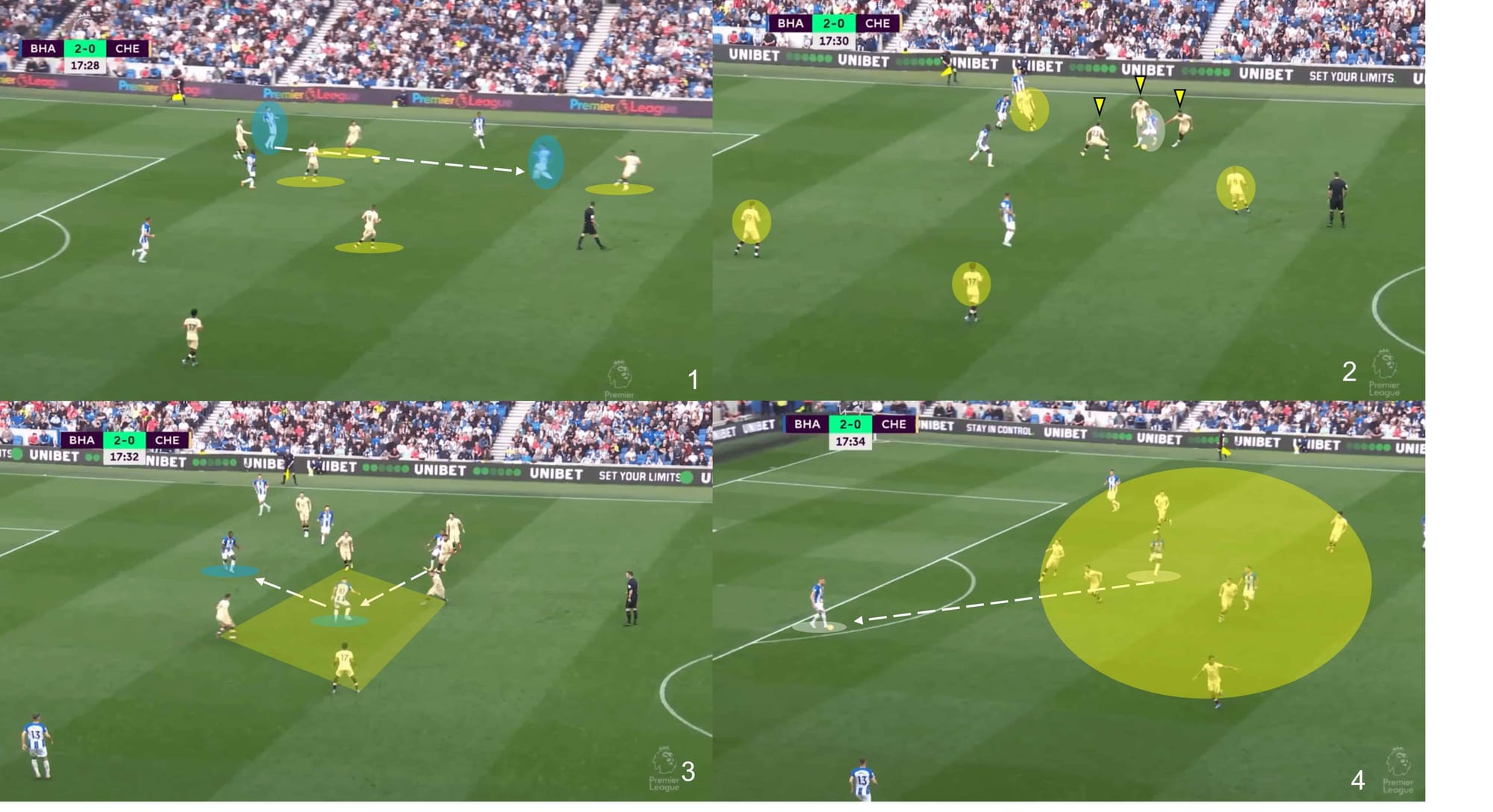
As we can see from the first image above, Brighton are not afraid to play out from the back but do so with the required urgent energy. In this case, Chelsea already had some numbers high up the pitch, which actually suited Brighton even more.
The pattern involves a more attacking player dropping in deeper to offer himself as an option – this also drags an opposition player from their position to mark him. From there, Chelsea, and other teams that have succumbed to de Zerbi’s tactics, think they have recognised a pressing trigger and look to surround the man on the ball (picture two). This is where de Zerbi puts his faith in the individual technical ability and composure within his squad, as the midfielder on the ball will look to create an opening for the next pass out of danger.
The unit press from the opponent is likely to continue as they still sense danger since Brighton are not yet in a position to go forward or gain comfortable control of possession. Again, this plays into Brighton’s hands, as the opponent’s eagerness to press will only create the needed space for the next pass. With quick thinking and quick actions, the ball ends up with a player in space, and a good collection of opposition players on the other flank, leaving plenty of space to exploit.
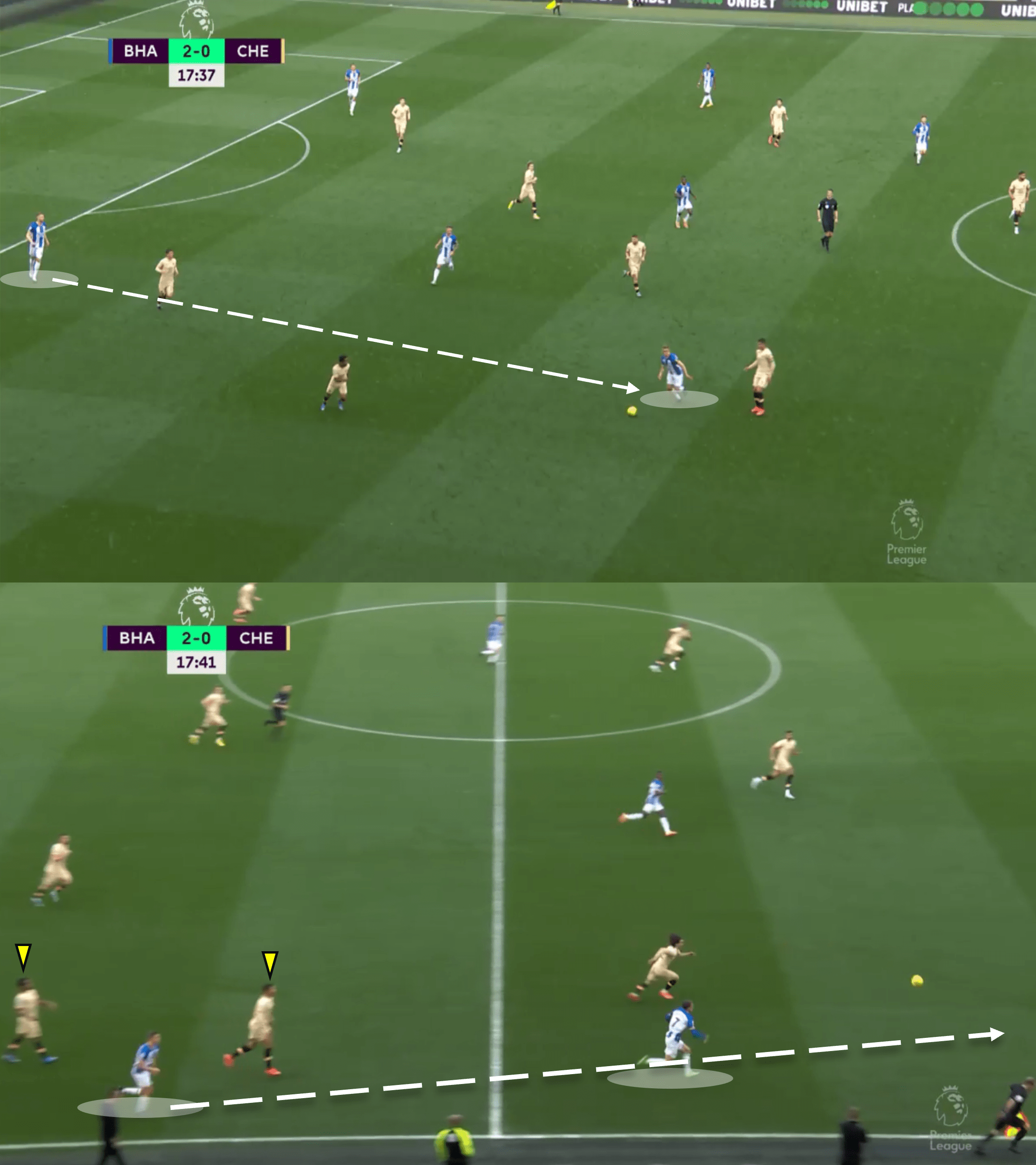
In the two images above, straight away you will notice the difference in space that Brighton have, as well as the number of Chelsea players close by. They look to use both of these to their advantage, quickly gaining distance up the pitch.
Along with the clever tactics, individual ability makes Brighton very dangerous on the ball, not to mention entertaining. This example sees a lofted ball played down the right flank, which required Solly March to beat ex-Brighton player Marc Cucurella in a foot race; he succeeds, leading his side into a dangerous attack.
One of their key players in attack is Belgian winger, Leandro Trossard. At 27 years of age, he is in what should be his prime years as a player – which could explain his impressive campaign thus far.
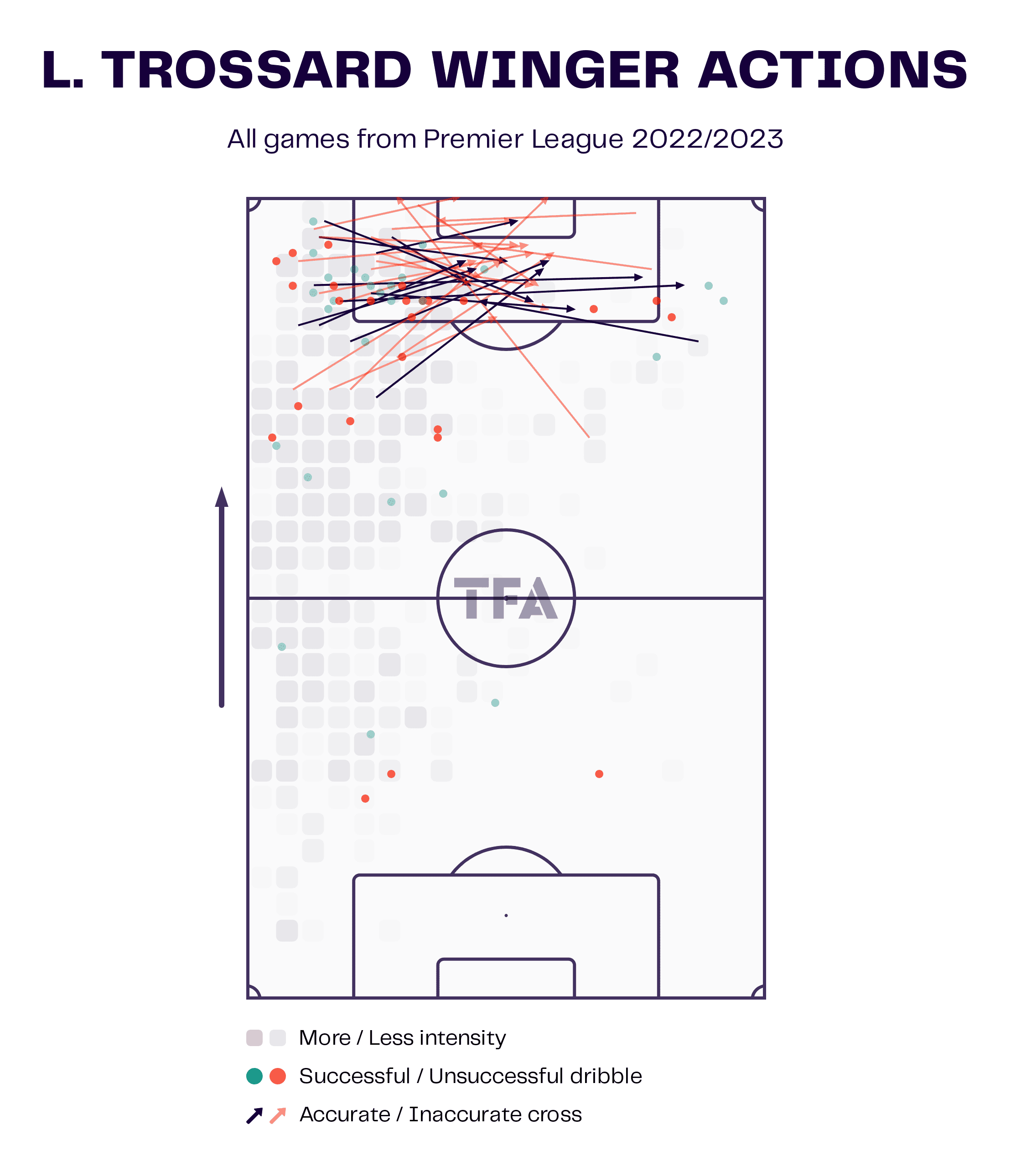
As we can see from the visual above, Trossard has been highly involved in the final third for Brighton this season. Most of his contributions occur on the left flank, with a high level of dribbles attempted, as well as a strong number of crosses. Trossard has registered seven goals this season, with three of them coming against Liverpool in de Zerbi’s first game in charge – he became the first-ever Brighton player to score a Premier League hattrick, and also the third-ever away player to score a hattrick at Anfield.
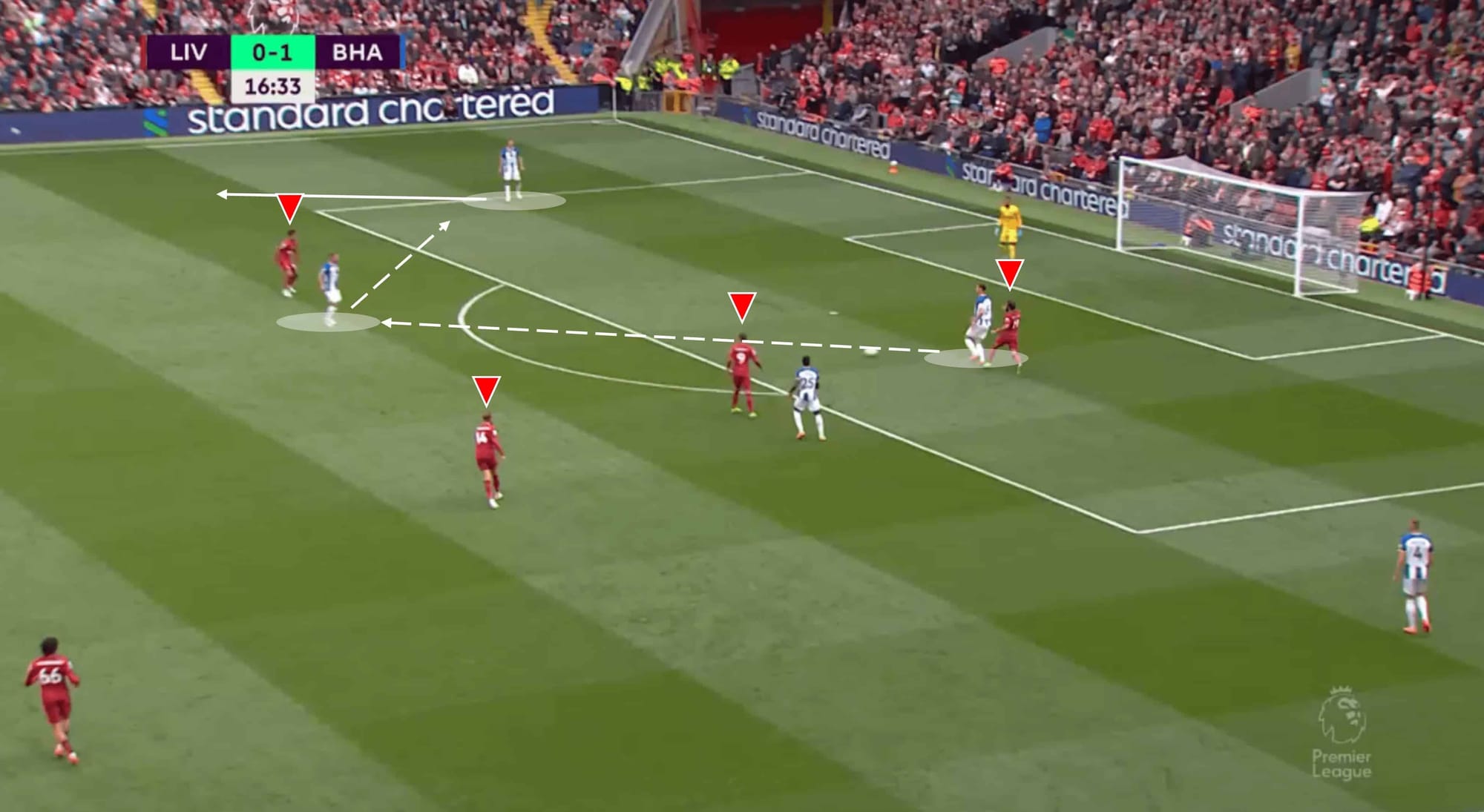
Speaking of that game at Anfield, we saw early signs of de Zerbi’s philosophy coming to fruition. Liverpool are a team renowned for their energy and pressing out of possession, so it may have been somewhat predictable – de Zerbi may well have been rubbing his hands together at the prospect of showing the Premier League what he can do against one of the best teams around in the modern game.
Brighton’s confidence already took a boost thanks to Trossard’s first of three goals on the afternoon, giving them an early lead in Merseyside. And while his second goal came after some direct play and fortune, the passage of play started with some classy possession play, beating Liverpool’s press along the way.
A simple yet key element that you see in the image above is the angles that each Brighton man is playing off the ball. Also consider that the first pass goes into the central midfielder who appears to be marked, Alexis Mac Allister, rather than passing to the defender at the top of the image. This was done by design – Brighton knew that playing the pass into Mac Allister would draw the marker in even tighter and open up the space for the defender to drive into when he does receive the ball: this is exactly what happened.
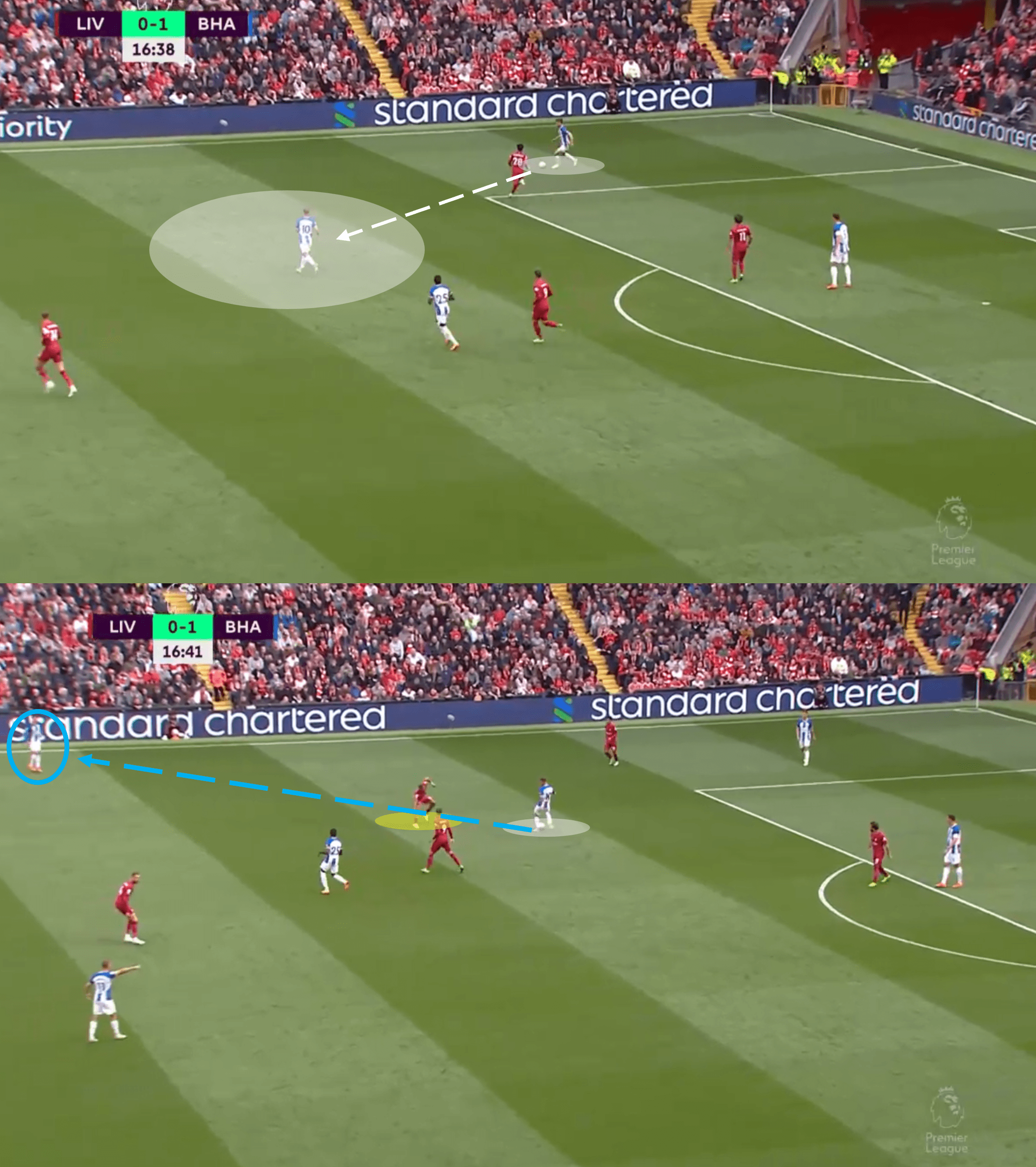
The next phase of the passage involves positive work from Brighton, but also a missing cog in the machine that is the Liverpool press. Notice the first of the two images above, as Mac Allister is receiving the return pass, there is no red shirt anywhere near him, giving him the time to turn and see what’s on offer. Eventually, Thiago applies the press in a rushed fashion, knowing he should have acted sooner.
Mac Allister fronted up against Thiago with good body language and composure and picked a simple pass out to the right flank, again in good space thanks to movement off the ball. And that is where the direct play and good luck come into play, but how Brighton just breezed through Liverpool’s press without breaking a sweat is a sight to behold, and we will only see more of the same from de Zerbi’s team as the season goes on.
Pressing
As with many teams who look to play with high energy, Brighton also look to transfer that energy into their defensive efforts. Counterpressing during transitions and pressing against general possession are both big factors in Brighton’s tactics off the ball – this segment of analysis will look at their pressing, analysing the pros and cons involved.
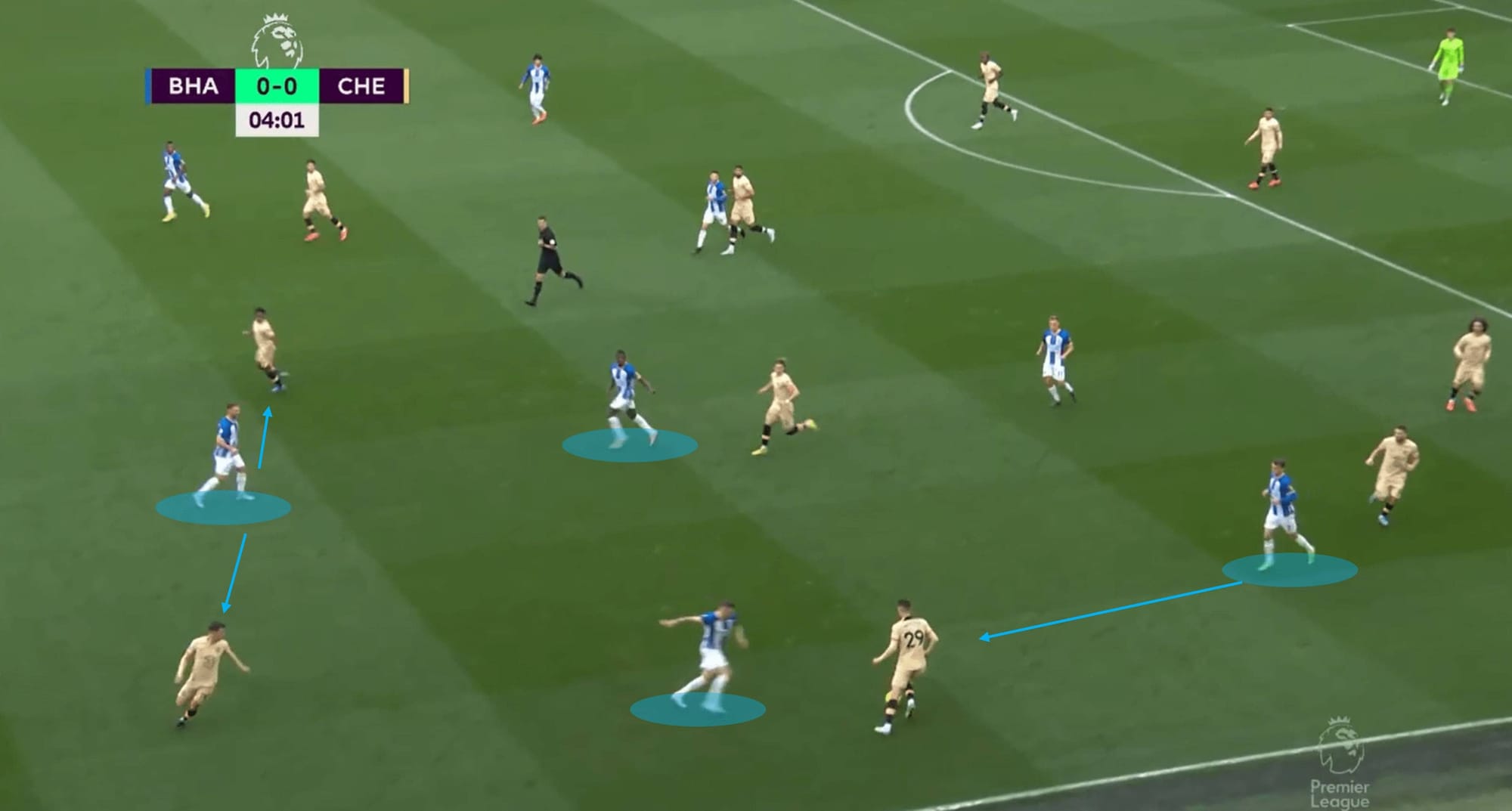
The counter-press is an interesting tactic in the modern game as it gives your team a possibility of regaining possession quickly, often in high/dangerous ideas. Of course, it does come with risks such as depleting fitness levels or a player(s) not being fully focused and reacting quickly enough in tandem with the passage of play, but if you as a coach can fine-tune the system to work with your squad and help them adapt as well, you’re onto a winner.
Brighton have shown signs early on that they will usually look to apply the pressure when losing the ball instead of putting the brakes on and regrouping, and they’ve had some success so far. Their positioning is good, and as we can above, they leave little space – both in terms of between themselves and the opponent, but also between themselves as teammates, making it even more difficult to break through.
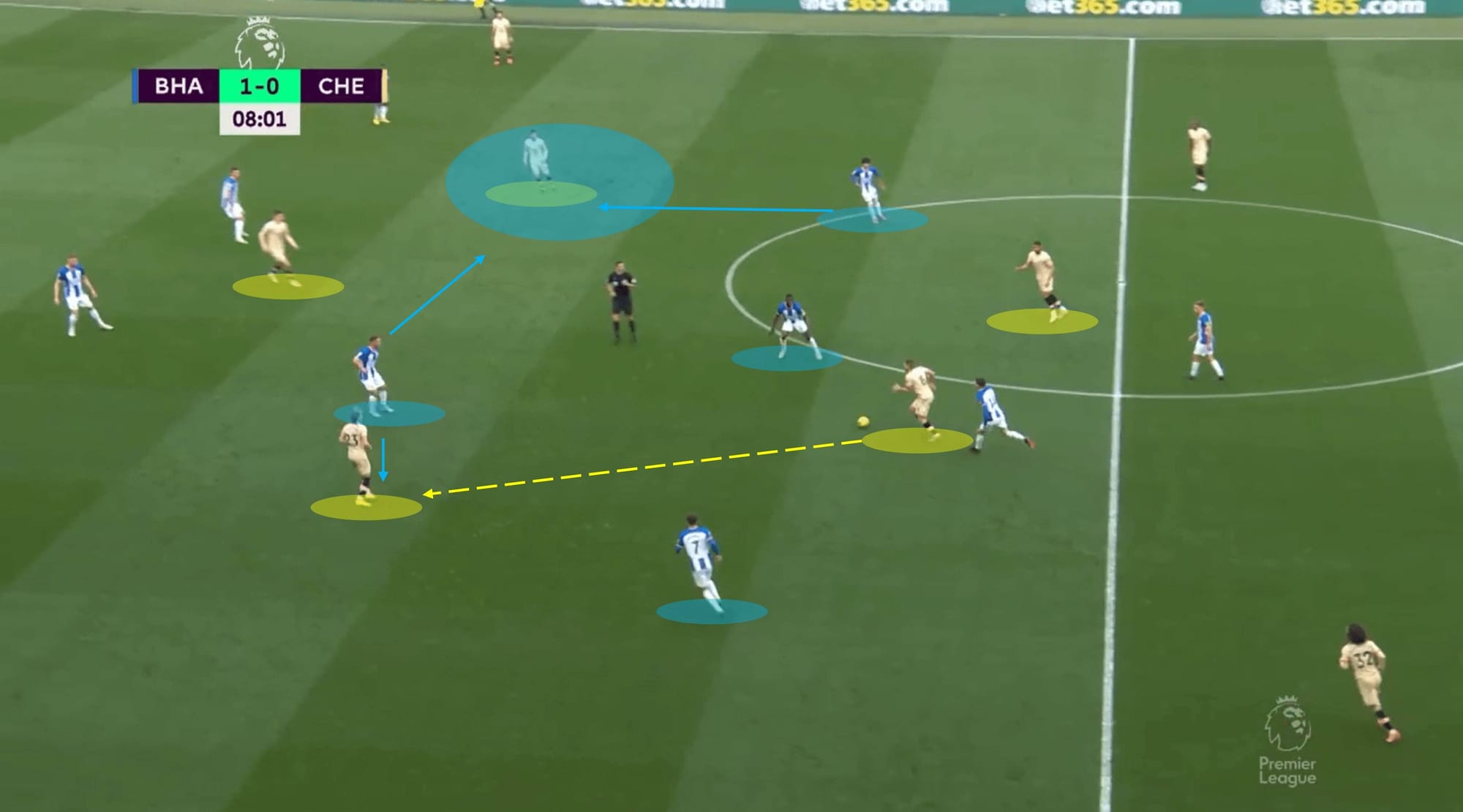
There are times, however, when things just don’t go according to plan. There are a number of things wrong for Brighton in the image above, but it stems from just how Mateo Kovačić found himself in the position he is, running at Brighton’s midfield in their own half. There was a press put onto the Croatian, but he was able to slip by the challenge and there was no reacting press from a Brighton player – he was simply allowed to continue.
We could go through the number of positional re-shuffles Brighton could have undergone to adjust to the situation accordingly, because there are many options. Instead, we focus on the outcome of the Seagull’s failed isolated press. For a start, Kovačić is running at them at speed in their own half.
Then there’s the multitude of passing options at his disposal – the blue-highlighted Chelsea player found himself in a particularly dangerous space thanks to the lack of positional cover from Brighton. But Kovačić instead opted to find Conor Gallagher, who wasn’t tightly marked – again a result of the lack of positional cover, meaning Mac Allister couldn’t mark Gallagher tightly as he was caught in two minds about remaining central, which would allow him to react and defend regardless of where the pass went.
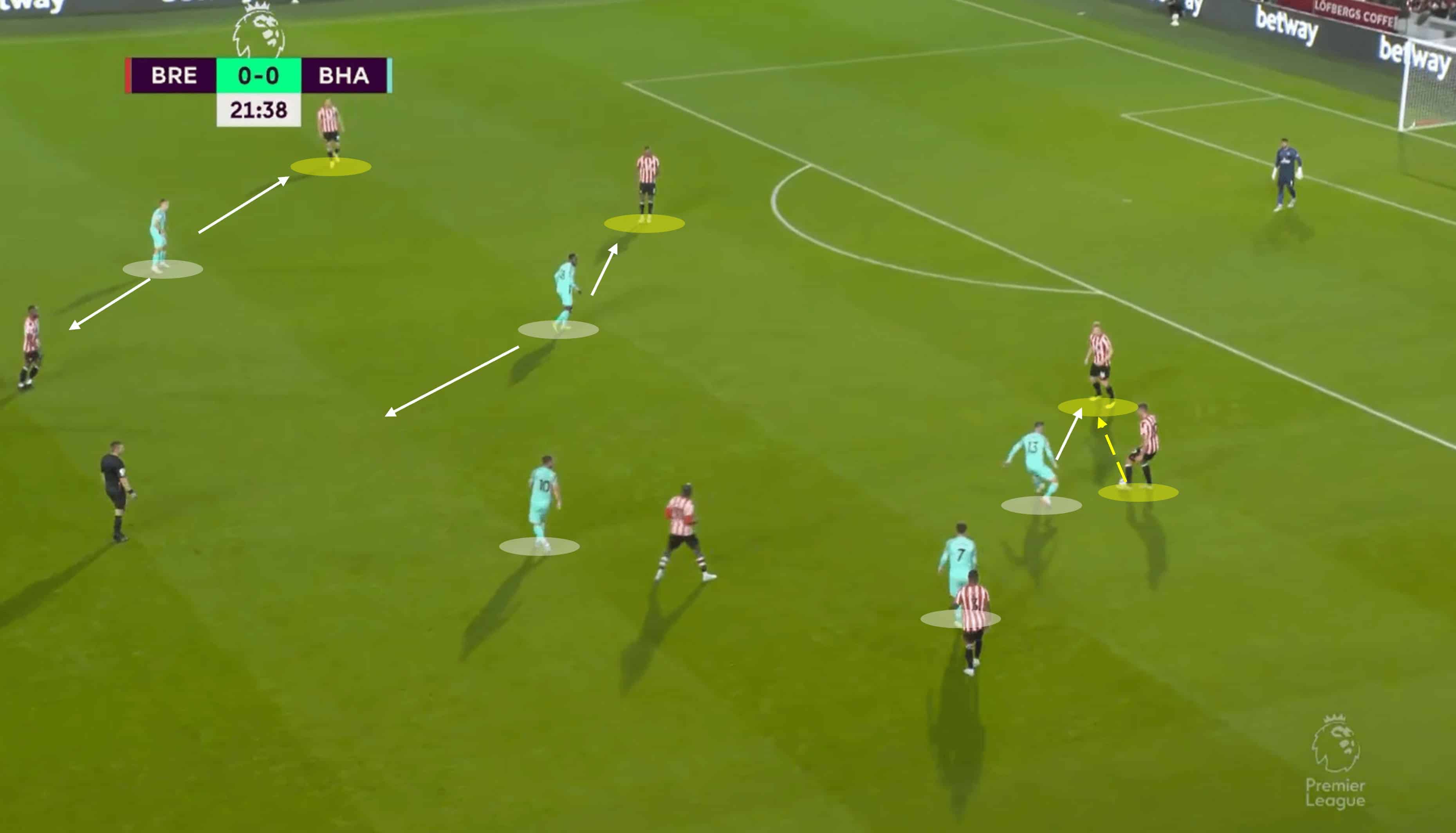
Back to the positives now, with an example of a good press from Brighton. With Brentford playing on their heels slightly and being hesitant on the ball, Brighton’s set-up says it all – they smell blood. Five players in the shot – that’s five players high up the pitch after 20 minutes away at Brentford with the score 0-0, highlighting just what de Zerbi is all about.
For every red and white Brentford shirt, there is a Brighton shirt to match. Pressure on the man on the ball, with those on standby waiting in anticipation of the pass, practically marking their man. Brentford would not take the risk of trying to beat this press and the ball ended up with the goalkeeper.
Defensive shape
As mentioned, pressing comes with the risk of fatigue, which is why it is difficult to sustain over a long period of time. In fact, we sometimes see teams needing to sit back and soak up the pressure due to pushing the press too hard and too far for too long, Brighton seem to have a good balance on that front, but also knows how to set up in a low/mid-block when required – it isn’t perfect though. Let’s look at what they do well and where they can improve.
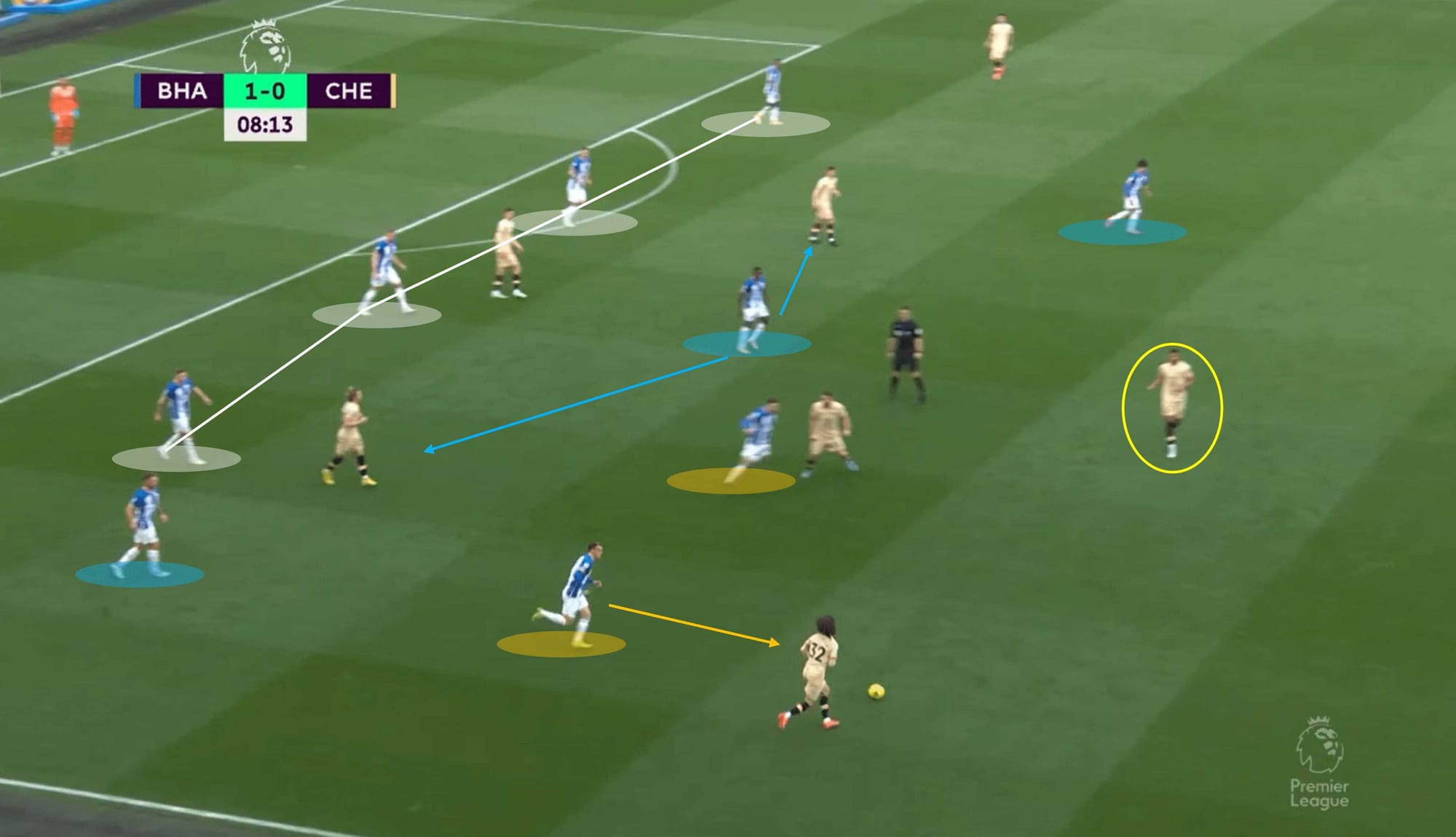
A compact back four with midfielders closing spaces in front is a good basis for a defensive set-up – those at the forefront of the set-up applying immediate pressure is a good move too. Breaking it down individually, however, a few questions are raised. Why is Mac Allister, a central midfielder, having to slot in on the right flank – or why hasn’t he returned to the centre? Why are Chelsea afforded an unmarked midfielder with a large helping of space all around him?
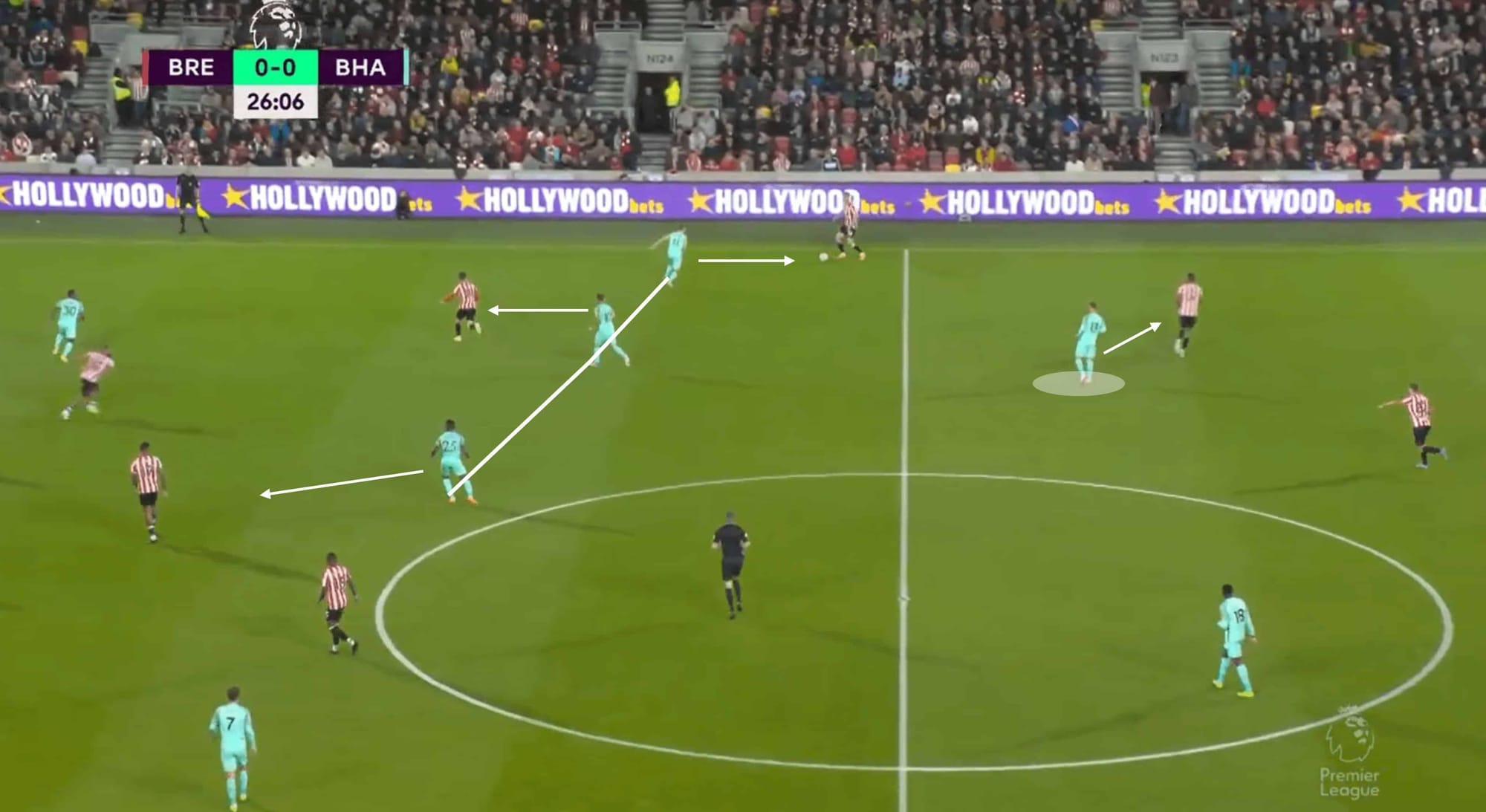
This setup against Brentford, however, is much better. Sure, it is a different scenario to the Chelsea example, but Brighton still demonstrate good defensive qualities. They look to keep their midfield unit compact while monitoring and tracking opposition players who are potential passing options. Pressure on the ball is also present, and Brentford’s option of passing backwards was limited to just the keeper as the nearest defender had been marked.
Conclusion
If you’re a Brighton fan, this is a very exciting time. After the panic of Potter leaving the Seagulls, they have seemingly found a manager who is also capable of increasing their stock and taking them to the next level. Impressive tactical traits are seen in Brighton’s approach play, with a good level of variety to maintain that level of mystery.
Their efensive tactics are an area that needs some sanding and development, but the foundations are certainly there, and calling them weak defensively would be inaccurate – it is just the area of the game where they need improvement the most.
A top-half finish is a realistic goal for Brighton this season, and who isn’t to say that they can’t surprise everyone and qualify for one of the European competitions?

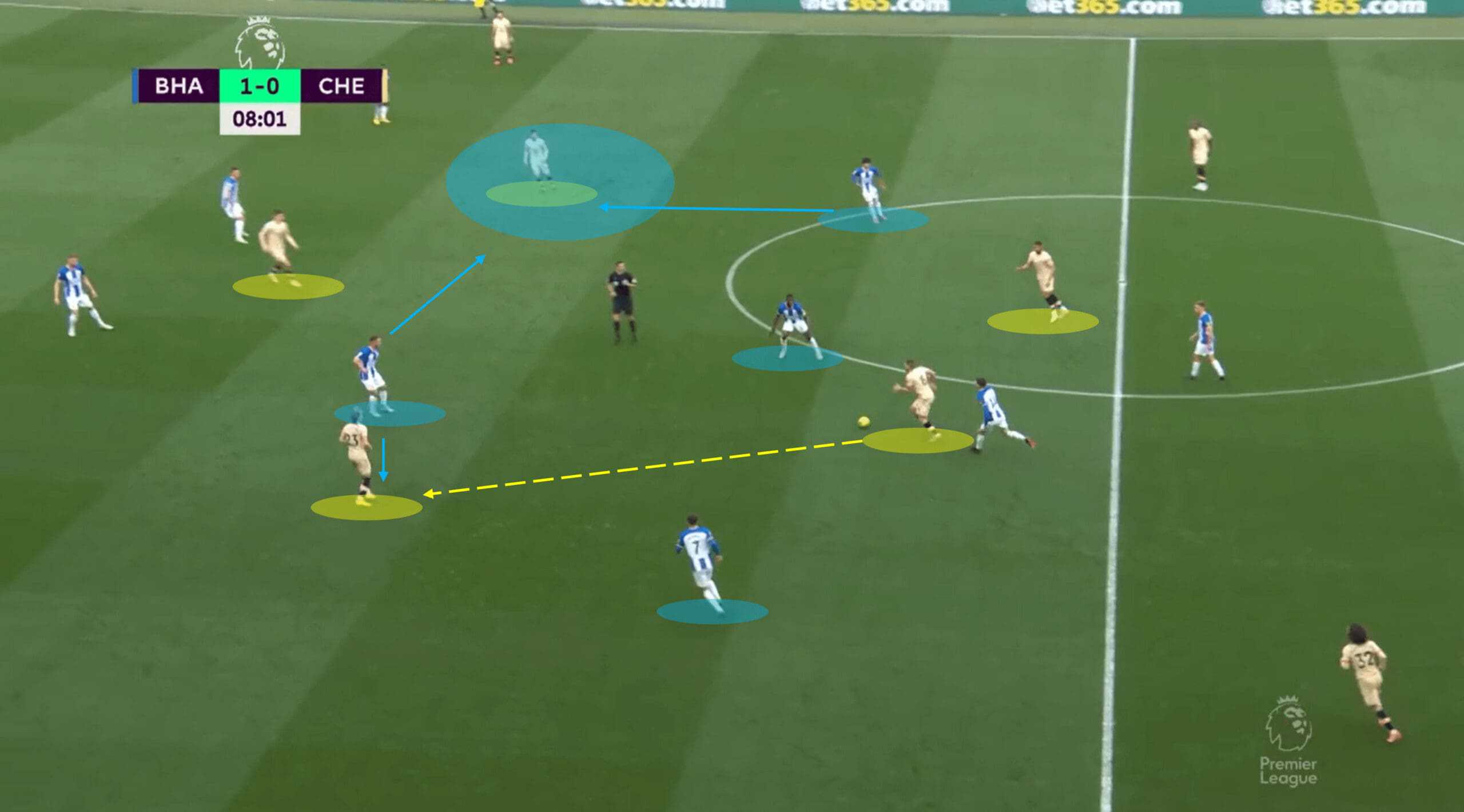



Comments